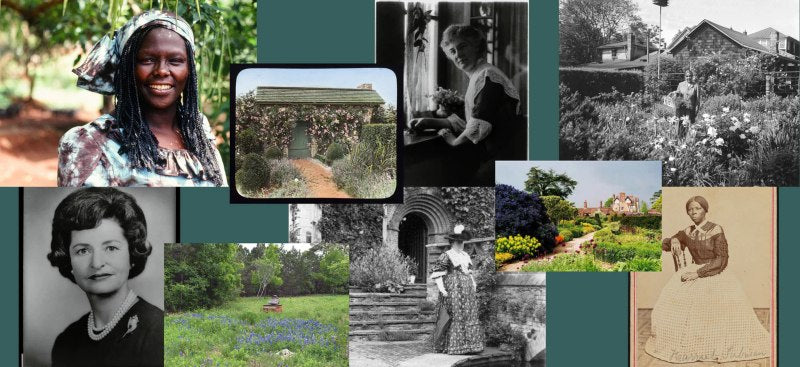March is Women’s History Month, and we are celebrating by recognizing a few influential women in horticulture history that we admire! It is inspiring to realize the impact women have made in botany, horticulture, and landscaping from all corners of the world. Many women in the horticulture industry have planted, created, painted, and written about the same plants that we have in our lives today. It is amazing to see the growth (pardon the pun) these trailblazing women below have accomplished, as well as paved the way for future leaders in the industry.
Here are just a few women in horticulture history we chose to highlight.

Harriet Tubman (1822-1913)
Harriet not only paved the way as an herbalist, but she also found plants for medicinal remedies to help people traveling in the underground railroad. Kings Apron’s blog calls her the "freedom forager", which is a perfect title because not only did she make a mark on "HERstory”, but she also foraged a new path for women in the horticulture industry.
Gertrude Jekyll (1840-1932)

Gertrude was a creative individual; therefore, it wasn’t much of a stretch for her to be an artist. Her creativity bloomed (another pun) into a love for horticulture. She became a garden designer in England and is known for a more natural style of design, rather than more formal English gardens. Her creativity always came to fruition in the form of photographs, gardens, and writing. Her work in garden design changed the way that England viewed and designed their gardens.
Mattie Edwards Hewitt (1869-1956)

Ms. Hewitt was at the forefront of taking photographs of American gardens. She took inspirational pictures for publications, showing people what their home landscaping could look like. During that time, many people were building companies and thriving thus, they had disposable income to spend on elaborate gardens for their homes; getting inspiration from the photographs that Mattie took. Mattie captured photographs of elaborate gardens and some of those pictures can still be found today in the Smithsonian.
Anne Spencer (1882-1975)
Having a home garden inspired Anne to write beautiful poems. Her poems centered around religion, mythology, her garden, and nature. One of her admirable qualities is that she was a strong advocate for equal rights for African Americans throughout her life. She was a librarian and teacher by trade and writing was her passion. Here is an example of one of her nature poems:

Find more of Anne's poems here!
Lady Bird Johnson (1912-2007)

Once she became the first lady of the United States, Lady Bird Johnson started a program focusing on the "beautification" of people's surroundings. Stemming from an environmental standpoint, she wanted to plant more plants! She even had a helping hand in Congress’ passing of the Highway Beautification Bill in 1965. She led the way in Wildflower research by establishing what is now called the Lady Bird Johnson Wildflower Center.
Wangari Muta Maathai (1940-2011)

Wangari is known for starting the Green Belt Movement, where women planted over 30 million trees to help sustainable development. She encouraged women to look locally and plant where they could. On the Nobel Peace Prize website, the Nobel Committee said, "She thinks globally and acts locally." A great example to follow when it comes to sustainability because starting globally can be overwhelming. Starting locally is an easier first step to a sustainable future. Wangari Muta Maathai's is a great pioneering example in the horticulture industry.
Many women throughout the years have been influential in the horticulture industry. The six women featured above merely scratches the surface the strides women have taken throughout history.
For more information about women who play key roles in the horticulture industry, check out AmericanHort's series on Women in Horticulture, where they feature and interview a woman who is making history right now in the industry every month.
More Resources we found interesting:
https://blog.nwf.org/2020/03/breaking-ground-pioneering-women-in-botany-public-horticulture/
https://www.kingsapron.com/single-post/harrietfreedomforager
https://www.americanhort.org/programs/women-in-hort/
https://www.whiteflowerfarm.com/blog/2019/05/06/saluting-some-of-historys-greatest-female-gardeners/
https://www.womenshistory.org/articles/gardening-clubs
https://www.womenshistory.org/education-resources/biographies/anne-spencer

Love seeing those women! And perhaps we need to look at more local women who influenced our NW gardens. My most favorite was Dulcy Mahar, Oregonian garden writer and local book author. She suffered from “plant lust” every Spring and gave me permission to buy even one of everything that caught my eye. Also Hulda Klager, of the Lilac Garden Fame. Reading how she developed present day splendid lilacs is eye opening. I am the proud owner of Gertrude Jeykll rose bush and a Frank Klager lilac! And I was privileged to visit Dulcy’s home garden.
Thank you for honoring women! I enjoyed reading about them.🥰
This is a great article. Thank for highlighting these interesting women.
Totally missed an opportunity to educate about the garden creations of Salem’s first female landscape architects Elizabeth Lord and Edith Schryver. Google them!
What about the great Hulda Klager with the Lilaks?
Leave a comment